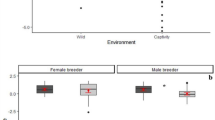Abstract
Spotted hyaenas (Crocuta crocuta) cooperate little in raising their young1, in contrast to other social carnivores2–11. It has been contended that the average relatedness between adult spotted hyaenas in a clan is so low that there is no kin selection pressure in favour of helping to rear young12. In the southern Kalahari, however, I found that there is a high degree of relatedness between the members of clans and that kin selection may be implicated in ways other than cooperation in raising young.
This is a preview of subscription content, access via your institution
Access options
Subscribe to this journal
Receive 51 print issues and online access
$199.00 per year
only $3.90 per issue
Buy this article
- Purchase on Springer Link
- Instant access to full article PDF
Prices may be subject to local taxes which are calculated during checkout
Similar content being viewed by others
References
Kruuk, H. The Spotted Hyena, a Study of Predation and Social Behaviour (University of Chicago Press 1972).
Kühme, W. Z. Tierpsychol. 22, 495–541 (1965).
Mech, L. D. The Wolf (Natural History Press, New York, 1970).
Schaller, G. B. The Serengeti Lion, a Study of Predator-Prey Relations (University of Chicago Press, 1972).
Bertram, B. C. R. J. Zool 177, 462–482 (1975).
Rood, J. P. Nature 248, 176 (1974); Z. Tierpsychol. 48, 277–287 (1978); Anim. Behav. 28, 143–150 (1980).
Camenzind, F.J. in Coyotes: Biology, Behaviour and Management (ed. Bedkoff, M.) 267–294 (Academic, New York, 1978).
Macdonald, D. W. Nature 282, 69–71 (1979).
Moehlman, P. D. Nature 277, 382–383 (1979).
Mills, M. G. L. Behavl Ecol. Sociobiol. 10, 131–136 (1982).
Owens, D. D. & Owens, M. J. Nature 308, 843–845 (1984).
Bertram, B.C.R. in Serengeti, Dynamics of an Ecosystem (eds Sinclair, A. R. E. & Norton-Griffiths, M.) 221–248 (University of Chicago Press, 1979).
Caraco, R. & Wolf, L. L. Am. Nat. 109, 343–352 (1975).
Lamprecht, J. Z. Tierpsychol. 46, 337–343 (1978).
Mills, M. G. L. Z. Tierpsychol. 63, 331–342 (1983).
Watson, R. M. E. Afr. Wildlife J. 122–123 (1965).
Henschell, J. R., Tilson, R. & von Blottnitz, S. Afr. Archaeol. Bull. 34, 127–131 (1979).
Author information
Authors and Affiliations
Rights and permissions
About this article
Cite this article
Mills, M. Related spotted hyaenas forage together but do not cooperate in rearing young. Nature 316, 61–62 (1985). https://doi.org/10.1038/316061a0
Received:
Accepted:
Issue Date:
DOI: https://doi.org/10.1038/316061a0
This article is cited by
-
A spotted hyaena den in the Middle Palaeolithic of Grotta Paglicci (Gargano promontory, Apulia, Southern Italy)
Archaeological and Anthropological Sciences (2016)
-
Philopatry, reproductive success of females, and maternal investment in the red-necked wallaby
Behavioral Ecology and Sociobiology (1986)
Comments
By submitting a comment you agree to abide by our Terms and Community Guidelines. If you find something abusive or that does not comply with our terms or guidelines please flag it as inappropriate.



